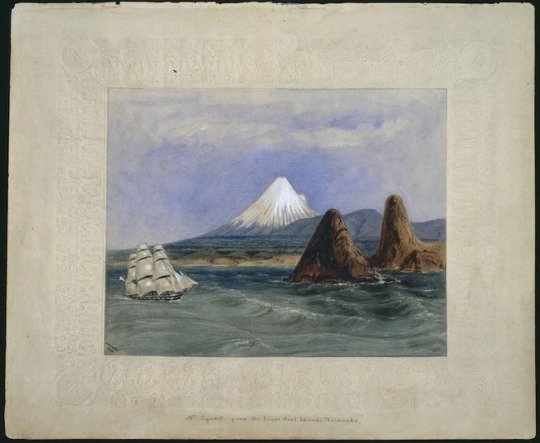#orocrambus
Explore tagged Tumblr posts
Text
The Great ACT-NSW-NZ Trip, 2023-2024 - Taranaki Maunga
A 2,518 metres (8,261 ft) tall stratovolcano, ideally positioned to catch every change in the weather coming off the Tasman. As a result it gets up to 11 meters of rain a year, and the winds between the peak and the remains of its predecessor can exceed 130kph.

Naturally, of great importance to the local iwi, and it certainly made an impression of the Europeans too - although a lot of early paintings exaggerate the height.

watercolour by Charles Heaphy, some time between 1839 and 1849.
They named it Mt Egmont, although happily the original name is back to being the official one.
The volcano erupts, on average, every 90 years, with major eruptions every 500. Of considerably more concern are the repeated catastrophic cone collapses that turn most of the volcano into gigantic landslides sweeping fridge-sized boulders and smaller debris dozens of kilometers away from the volcano, and well past the current coastline.
Anyway, while we wait for it to go bang again, visitors can enjoy the fascinating change in vegetation as you go up the mountain. As you get higher and higher, the coastal vegetation is replaced by the goblin forests, contorted mossy woods dominated by Kamahi (Weinmannia racemosa), that developed after eruptions destroyed the preexisting podocarp and Nothofagus forest, and as you go higher the trees are replaced by tussock grasses and later alpine plants.



There are still kiwi in the national park, which is one reason dogs are strictly banned. The introduced stoats continue to be a problem - we saw one on one of the tracks.

There was also this building, a corrugated iron structure noteworthy for being the oldest such building left anywhere in the world. It was originally a fort, and still has gun slits. The windows are new.
Most of the species I saw around the visitors center are were new to me - I could have spent a week just phtographing the incredible lichens in the goblin forest. Here's some that weren't new.





And a few lichens I don't have an ID on.



#taranaki#new zealand volcano#mount taranaki#taranaki maunga#orocrambus#new zealand moth#crambidae#miro#podocarp#new zealand plant#Pectinopitys#podocarpaceae#asteraceae#Olearia#kamahi#Weinmannia#Cunoniaceae#Charles Heaphy#asplenium#new zealand fern#aspleniaceae#spleenwort#goblin forest
11 notes
·
View notes
Text



Common grass moth
Orocrambus flexuosellus is a species of moth of the Crambidae family. It is found in New Zealand, where it has been recorded from the North and South Island and the Stewart Islands. The habitat consists of lowland to alpine grasslands.
47/22 Northcross Drive, Oteha, Auckland 0632
7PJC+H3R Auckland
-36.7185165, 174.7201332
14 февраля 2023
Там же




2 мая 2024



0 notes
Note
Hi Gonta, thank you for sharing all these great bug facts! Now, I must hear your expert opinion. Which bugs do you think are the cutest?
This is a very tough question, but Gonta will try his best to answer it with a list of cutest insects under the cut!
Periplaneta americanaPolistes chinensisPolistes chinensisStenolemus fraterculusCebysa leucotelusCebysa leucotelusDelena canceridesAnisops wakefieldiArtona martiniAntichloris viridisAntichloris viridisHexathele hochstetteriCimex lectulariusPlatyzosteria novaeseelandiaePorrhothele antipodianaTrite planicepsParisopalpus nigronotatusHypolimnas bolina nerinaLiposcelis divinatoriusEucolaspis brunneaEucolaspis brunneaCantareus aspersusHofmannophila pseudospretellaThysanoplusia orichalceaArhopalus tristisEpiphryne verriculataEpiphryne verriculataEpiphryne verriculataPieris rapaeAnthrenus verbasciArtona martiniTyria jacobaeaeDeclana atroniveaHaemaphysalis longicornisGymnoplectron acanthocerumAmphipsalta zelandicaTyria jacobaeaeConoderus exsulCydia pomonellaLiothula omnivoraLiothula omnivoraZizina otis labradusLycaena salustiusTeleogryllus commodusPholcus phalangioidesSuborder ZygopteraCryptamorpha desjardinsiArgyrodes antipodianaEphestia cautellaStegobium paniceumAnisolabis littoreaPhoracantha semipunctataForficula auriculariaSteatoda capensisOrthoclydon praefactataTmetolophota steropastisExaireta spinigeraBlatella germanicaVespula germanicaUropetala caroveiMegarhyssa nortoni nortoniLasiorhynchus barbicornisDrymaplaneta semivittaCostelytra zealandicaOrocrambus flexuosellusChrysodeixis eriosomaSiphanta acutaCosmodes elegansNezara viridulaNezara viridulaCoscinoptycha improbanaOpodiphthera eucalyptiUraba lugensPediculus capitisAethina concolorDermestes maculatusApis melliferaLeucauge dromedariaAnobium punctatumMusca domesticaPrionoplus reticularisPlodia interpunctellaCaedicia simplexCleora scriptariaUresiphita polygonalis maorialisAgrius convolvuliCryptolaemus montrouzieriPericoptus truncatusPieris brassicaeEpiphyas postvittanaOemona hirtaXanthocryptus novozealandicusFannia canicularisDanaus chrysippus petiliaDanaus chrysippus petiliaEpiphyas postvittanaLocusta migratoriaNyctemera annulataPison spinolaePison spinolaeCryptolaemus montrouzieriMotuweta isolataThyreocephalus orthodoxusTrimescaptor aoteaDanaus plexippusPhaulacridium marginaleOrthodera novaezealandiaeDeclana atroniveaNetelia ephippiataDasypodia cymatodesTeia anartoidesCynthia carduiScolypopa australisConoderus exsulPeripatoides indigoArtona martiniAenetus virescensVanessa gonerilla gonerillaSitophilus oryzaeChrysodeixis eriosomaLepisma saccharinaPorcellio scaberAustrosciapus proximusAncistrocerus gazellaMiomantis caffraThysanoplusia orichalceaParisopalpus nigronotatusClitarchus hookeriThelyphassa lineataArocatus rusticusPolistes humilis humilisHelophilus seelandicusHelicoverpa armigera confertaParopsis charybdisHemideina thoracicaSpodoptera lituraSpodoptera lituraCoptomma variegatumDrosophila melanogasterVespula germanicaSigara arguataPieris rapae rapaeOrgyia thyellinaEchthromorpha intracatoriaSirex noctilioAnthidium manicatumNyctemera annulataVanessa itea
Gonta’s fingers are starting to get very tired and he still has a paper to finish, so he hopes that this very incomplete list is enough to fulfill your request. Sorry…
6 notes
·
View notes
Text
#2301 - Orocrambus vittellus - Common Grass Moth


A Crambid endemic to most of New Zealand, first described by English entomologist and ornithologist Henry Doubleday in 1843. He was also the author of the first catalogue of British butterflies and moths, Synonymic List of the British Lepidoptera (1847–1850), and other species named by him include the pigmy footman, Ashworth's rustic and the marsh oblique-barred.
There's roughly 50 other Orocrambus species, all native to New Zealand. This one is most common in grasslands, where the larvae feed on Agrostis tenuis and probably other grasses.
Horopito, North Island Volcanic Plateau, New Zealand
8 notes
·
View notes
Text
#2647 - Orocrambus flexuosellus - Common Grass Moth

Originally described as Crambus flexuosellus by Edward Doubleday in 1843. I'm not sure what flexuosellus means, but Oro- means mountains and it's certainly found in alpine grasslands.
A Crambid moth endemic to Aotearoa, where it lives in grasslands over most of the country, and the caterpillars feed on grasses and sedges.
Lake Tekapo, Aotearoa New Zealand
1 note
·
View note